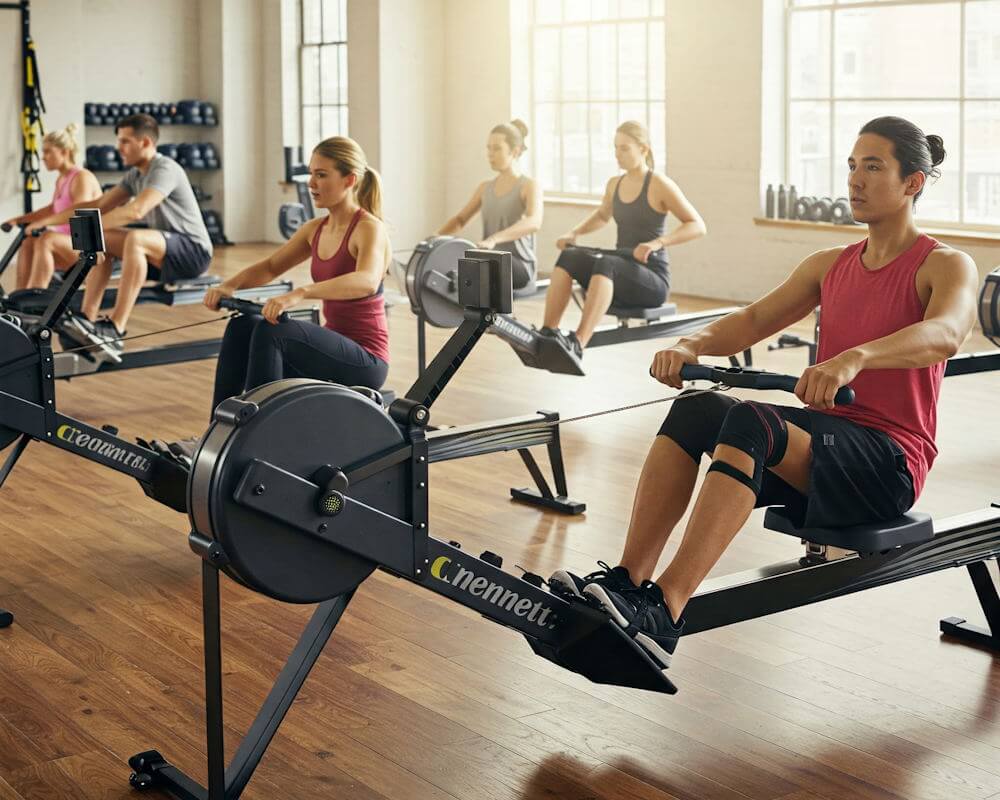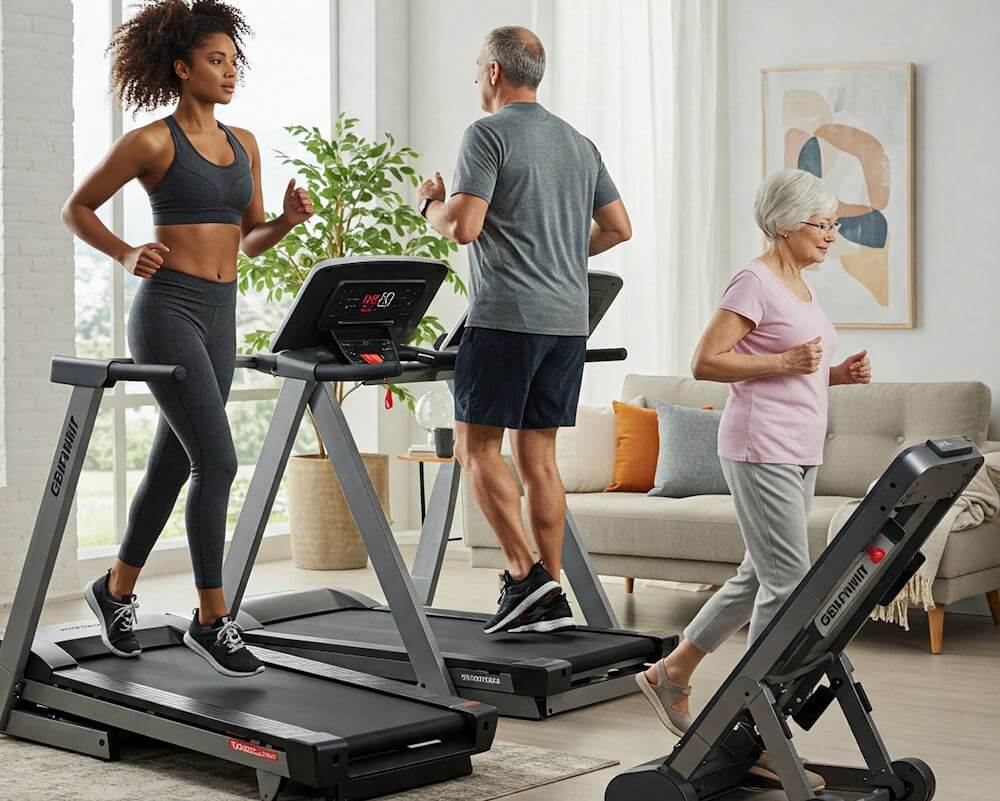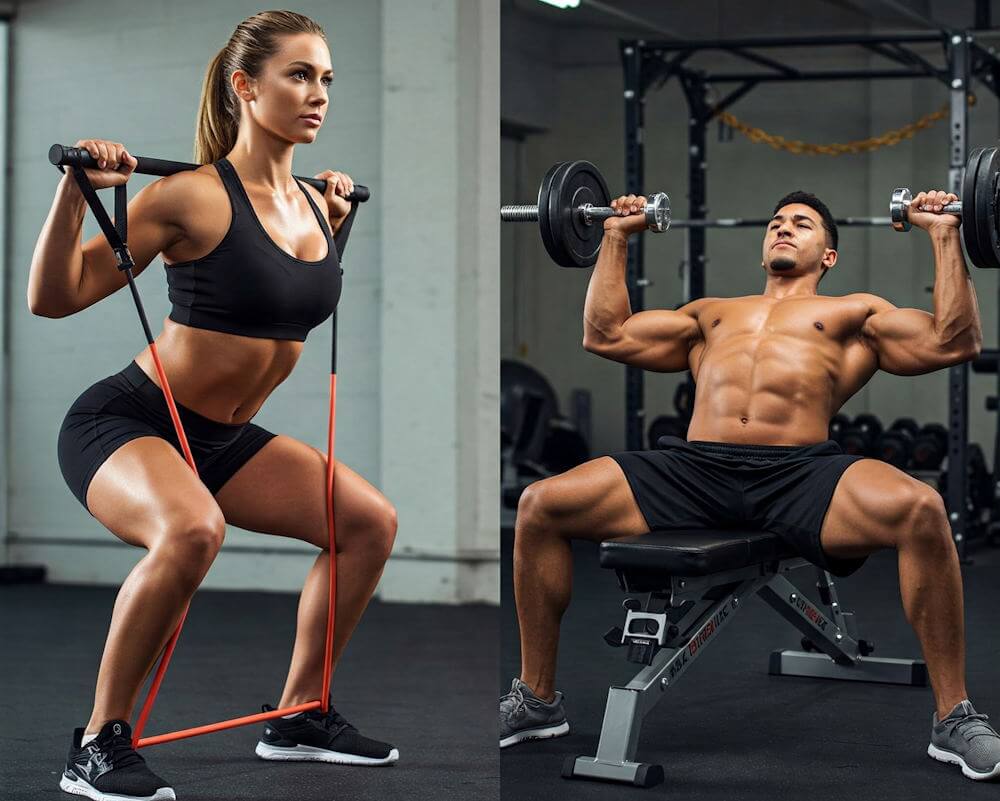Rowing machines, also known as ergometers, are versatile fitness machines designed to simulate the action of rowing a boat. By employing a sliding seat, handle straps, and a resistance mechanism, these machines engage multiple muscle groups, providing a comprehensive workout that encompasses both cardiovascular endurance and strength training. Unlike many traditional workout machines that might target isolated muscle groups, rowing machines offer a full-body workout that effectively activates the legs, core, and upper body simultaneously.
The primary movement on a rowing machine comprises four phases: the catch, drive, finish, and recovery. During the catch phase, users position themselves at the front of the machine with knees bent and arms extended. The drive phase begins when the user pushes down with their legs, utilizing powerful glute and quadricep contractions while simultaneously pulling the handle towards their chest, engaging the back and arm muscles. Following this, the finish phase sees the user draw the handle to their body, creating a momentary contraction of various muscle groups, before transitioning into the recovery phase, where they strategically prepare for the subsequent stroke. This cyclical motion not only mimics the boathouse experience but effectively resembles a comprehensive exercise routine.
Engaging in regular workouts with a rowing machine offers numerous health benefits. As a low-impact exercise option, it significantly reduces the risk of joint strain or injury, making it a suitable choice for individuals of varying fitness levels. Additionally, rowing efficiently elevates heart rates, aiding in cardiovascular fitness and calorie burning. The dual nature of the rowing machine promotes not only aerobic conditioning but also muscular strength, making it an ideal piece of equipment for those seeking a balanced, full-body workout experience. Furthermore, versatility in resistance settings enables users to customize their workouts according to personal fitness goals, thereby maximizing results from each session.
Benefits of Full-Body Workouts
Engaging in full-body workouts, particularly through the use of rowing machines, offers a myriad of advantages that contribute to overall health and fitness. One of the most notable benefits is the improvement of cardiovascular health. Rowing is an aerobic exercise that elevates the heart rate and enhances blood circulation, which can lead to lower blood pressure and a reduced risk of cardiovascular diseases. As a result, incorporating rowing sessions into a fitness routine can significantly bolster heart health.
In addition to cardiovascular enhancements, full-body workouts using rowing machines also promote increased muscle strength. Rowing engages a multifaceted range of muscle groups, including the legs, back, and arms, allowing for a comprehensive workout that stimulates muscle growth. This engagement builds strength and contributes to overall muscle toning, which can boost functional fitness and daily physical activity.
Another remarkable benefit of full-body workouts is the enhancement of endurance. As individuals regularly engage in rowing, they are likely to experience improvements in stamina and the ability to sustain physical activity over longer periods. This increase in endurance not only enhances performance in rowing but can also translate to improved efficiency in other forms of exercise.
Furthermore, full-body workouts are particularly advantageous for those looking to lose weight. The high level of calorie expenditure during a rowing session, combined with muscle engagement, contributes significantly to weight loss and fat reduction. The ability to burn calories while simultaneously building muscle makes rowing an efficient choice for weight management.
Lastly, one of the often-overlooked advantages of full-body workouts is their time efficiency. By engaging multiple muscle groups simultaneously, individuals can achieve maximal results in a shorter duration compared to traditional workouts that target single muscle areas. This efficiency makes rowing machines a practical choice for those with busy schedules seeking effective fitness solutions.
Factors to Consider When Choosing a Rowing Machine
When selecting a rowing machine, there are several key factors that one should take into account to ensure an effective and enjoyable workout experience. The first crucial aspect is the type of resistance, as it directly influences the intensity and feel of the workout. Rowing machines typically utilize one of four resistance types: air, magnetic, water, or piston. Air resistance models provide a dynamic rowing experience, as the resistance increases with the user’s effort. On the other hand, magnetic resistance offers a smooth and quiet operation, making it suitable for home use. Water rowers mimic the feel of real rowing by utilizing water for resistance, while piston-based machines are often more compact and budget-friendly.
Size and storage options are also vital considerations. Potential buyers should evaluate the dimensions of the rowing machine in relation to the available space in their home. Some rowing machines are designed for easy storage with foldable frames, while others may require dedicated space due to their larger size. Comfort features should not be overlooked; a well-padded seat and ergonomically designed handlebars can significantly impact the quality of the rowing experience, reducing the chance of discomfort during prolonged use.
The display type on a rowing machine is another important factor. A clear, user-friendly monitor can provide valuable information, such as distance, time, stroke rate, and calories burned, allowing users to track their progress effectively. Lastly, it is essential to establish a budget before making a purchase, as rowing machines come in a wide range of prices. Understanding the warranty options available for the equipment can also safeguard one’s investment, ensuring peace of mind in the event of any issues. By carefully evaluating these factors, individuals can select a rowing machine that best fits their workout needs and preferences.
Top Rowing Machines for Full-Body Workouts
When considering the best rowing machines for full-body workouts, it is essential to evaluate various factors such as features, usability, and budget. Below is a curated list highlighting top models that cater to diverse needs and preferences.
The Concept2 Model D has long been a favorite among fitness enthusiasts for its durability and performance. This air resistance machine offers a smooth rowing experience and is equipped with a performance monitor that tracks distance, speed, and calories burned. Its modular design allows for easy storage, making it ideal for home gyms. However, its higher price point may not suit every budget, typically retailing around $900.
Another excellent option is the WaterRower Natural, which uniquely features water resistance, providing a rowing experience that mimics real on-water rowing. Crafted from solid ash wood, it not only looks aesthetically pleasing but also offers a quiet, smooth operation. While its price is generally higher, closely aligning with the $1,000 mark, many users find value in its craftsmanship and the effectiveness of the full-body workout it provides.
If you’re searching for a budget-friendly alternative, the Stamina Body Trac Glider 1050 might be worth considering. This compact model is priced under $200, making it accessible for those new to rowing. While it lacks some advanced features of pricier models, it still delivers an effective workout using hydraulic resistance. Its foldable design ensures it occupies minimal space, making it suitable for smaller home environments.
Lastly, the NordicTrack RW900 stands out with its interactive coaching capabilities. This machine features a 22-inch touchscreen that offers a vast selection of workouts. With both magnetic and air resistance, it provides a versatile rowing experience for users at all levels. However, the price typically ranges around $1,600, which may be a consideration for prospective buyers.
Evaluating each of these options allows individuals to align their choice of equipment with their fitness goals, space constraints, and budget, ensuring the selection of the best rowing machine for full-body workouts tailored to their needs.
How to Use a Rowing Machine Effectively
Using a rowing machine effectively involves several key steps that ensure a full-body workout while minimizing the risk of injury. To begin, position yourself on the rowing machine. Adjust the foot straps, securing your feet comfortably in the footplates, allowing your heels to rest flat. This setup is crucial as it helps to stabilize your stance during the rowing motion.
Next, take a moment to focus on your posture. Sit tall, keeping your back straight and shoulders relaxed, which promotes proper alignment. Your knees should be bent and your shins vertical. Grip the handle firmly but not overly tight, allowing for a natural range of motion. As you prepare to row, engage your core muscles to support your back throughout the movement.
Begin your rowing motion by pushing off with your legs. This initial drive is vital; the power should primarily come from your legs, not your arms. Once your legs are fully extended, lean back slightly from your hips while maintaining a straight back, and then pull the handle towards your chest using your arms. Your elbows should move past your sides, engaging your upper body effectively. It’s important to reverse the movement fluidly, extending your arms first, then leaning your body forward and re-bending your knees to return to the starting position.
For beginners, start with shorter intervals and gradually increase your workout duration as you develop endurance and technique. A common mistake to avoid is using too much upper body strength to pull the handle, which can lead to improper form. Instead, focus on the coordinated movement of your legs, core, and arms for a balanced approach. Incorporate a steady rhythm, and remember to breathe consistently throughout your workout. Following this guidance will enhance your rowing experience and maximize the benefits of the full-body workout offered by the rowing machine.
Incorporating Rowing into Your Fitness Routine
Integrating rowing into your existing fitness regimen can be a highly effective way to enhance cardiovascular health, build muscle, and improve overall fitness. For beginners, it is crucial to start with manageable sessions, particularly as the rowing motion engages both upper and lower body muscles. Initiating your routine with two to three rowing sessions per week, each lasting 15-20 minutes, provides an excellent foundation. This frequency allows your body to adapt to the new demands placed upon it while minimizing the risk of injury.
For more advanced users, the incorporation of rowing can be adjusted to fit progressive goals. You might consider increasing the duration to 30-60 minutes per session or enhancing intensity through interval workouts. Combining rowing with other exercises, such as strength training or high-intensity interval training (HIIT), can lead to exceptional results. For instance, pairing rowing with compound lifts provides a balanced approach to fitness, targeting multiple muscle groups while boosting caloric expenditure. Depending on your schedule, alternating rowing days with strength workouts enables both recovery and performance improvement.
Tracking progress is essential for maximizing the benefits of rowing. Utilizing fitness apps or wearables that monitor metrics such as stroke rate, distance covered, and calories burned can inspire and inform your workouts. Additionally, periodic assessments, such as timed rows or distance challenges, allow you to measure improvements systematically. It is also beneficial to set specific, measurable goals—be it achieving a certain distance or improving stroke efficiency. By closely monitoring your journey, you will be able to optimize your routine, maintain motivation, and prevent plateauing in your fitness progress.
Rowing Workouts for Different Fitness Levels
Rowing is an exceptional full-body workout that caters to various fitness levels. Whether you are a beginner, intermediate, or advanced user, there are tailored workouts that can enhance your endurance, strength, and cardiovascular health. Understanding the nuances of each fitness level is crucial in maximizing the benefit of rowing sessions.
For beginners, it is advisable to start with short sessions, focusing on proper rowing technique to avoid injury. A suggested routine could include rowing for 10-15 minutes at a moderate pace, ensuring you maintain a steady rhythm. This initial stage will concentrate on building a solid foundation in rowing form and developing basic endurance. The focus should not only be on duration but also on integrating breathing techniques, which can significantly improve overall performance over time.
As one progresses to the intermediate level, workouts can be intensified by incorporating interval training. An effective routine may involve alternating between high-intensity rowing for 1-2 minutes and active recovery at a lower intensity for the same amount of time, repeated for about 20-30 minutes. This type of session boosts cardiovascular fitness and enhances stamina, ultimately preparing users for more demanding workouts.
For advanced users, the emphasis shifts towards more complex workouts that combine endurance and strength-building. Longer sessions of 30-45 minutes, coupled with resistance settings, can provide the challenge necessary for muscle development. Varied techniques, such as incorporating power strokes or different grip techniques, can keep sessions dynamic and engaging. Additionally, advanced users may integrate cross-training elements or rowing challenges to maintain motivation and ensure continued progression in their fitness journey.
Overall, selecting a suitable rowing workout aligned with one’s current fitness level is key to achieving personal health goals. By following the tailored routines for each fitness category, users can effectively elevate their rowing experience and enjoy the vast benefits that this form of exercise offers.
Real User Experiences and Testimonials
The first-hand experiences of individuals who have incorporated rowing machines into their fitness routines provide valuable insights into the effectiveness and versatility of these machines. Many users report significant transformations in their physical appearance and overall health, demonstrating the ability of rowing machines to facilitate comprehensive workouts. For instance, Sarah, a 32-year-old fitness enthusiast, noted that after six months of consistent rowing, she lost 20 pounds and significantly increased her cardiovascular endurance. She reported feeling more energetic and less fatigued throughout the day, thanks to her regimented workouts using her favorite rowing machine.
Another inspiring story comes from John, a retired athlete who turned to rowing after suffering an injury. Initially drawn to the low-impact nature of the rowing machine, John found that not only did it allow him to maintain his fitness levels, but it also helped him build strength and stability in his core. He praised the rowing machine for offering a full-body workout that challenges multiple muscle groups, allowing him to regain his athletic prowess while adhering to a safe rehabilitation plan.
User testimonials frequently highlight the ability to personalize workouts according to individual fitness levels. Many rowing machines come equipped with adjustable resistance settings, enabling users to tailor their experience. For example, Lisa, a beginner, shared her journey of gradually increasing resistance while maintaining her form. Over time, she successfully progressed from short sessions to endurance challenges that have enhanced her stamina and confidence.
The stories of transformation and growth from daily rowing sessions illustrate the impact that this equipment can have on fitness journeys. With engaging workouts and visible results, rowing machines have proven to be a powerful tool for those seeking effective, full-body workouts.
Conclusion and Final Thoughts
In this blog post, we explored the multifaceted benefits of rowing machines for achieving effective full-body workouts. Rowing machines stand out in the realm of fitness equipment due to their ability to engage multiple muscle groups, including the legs, back, arms, and core. This comprehensive engagement not only fosters strength development but also promotes cardiovascular endurance, making rowing an ideal choice for individuals seeking a balanced exercise regimen.
Choosing the right rowing machine is pivotal for maximizing these benefits. Factors such as resistance type, build quality, and ergonomic design must be carefully considered to ensure that the machine aligns with your fitness goals and personal preferences. Whether you opt for a hydraulic, magnetic, or air resistance rowing machine, each type has its unique advantages suited for various fitness levels and workout styles. As we highlighted throughout the post, the right choice can enhance overall comfort and efficacy during workouts, leading to better adherence over time.
For those contemplating the integration of rowing into their fitness routines, taking immediate action is essential. Start by assessing your fitness goals and identifying which specific benefits of rowing resonate most with you. Subsequently, consider testing different machines, if possible, to determine which feels best during use. Engaging with the rowing community, whether online or in person, can also provide invaluable insights and motivation.
We encourage you to reflect on your experiences with rowing machines. Have they fit into your workout regime? Do you find them beneficial? Your thoughts are welcome and can greatly assist others in their journey towards choosing the right rowing machine for their fitness needs. Ultimately, embracing rowing can lead to improved fitness levels and a healthier lifestyle.



